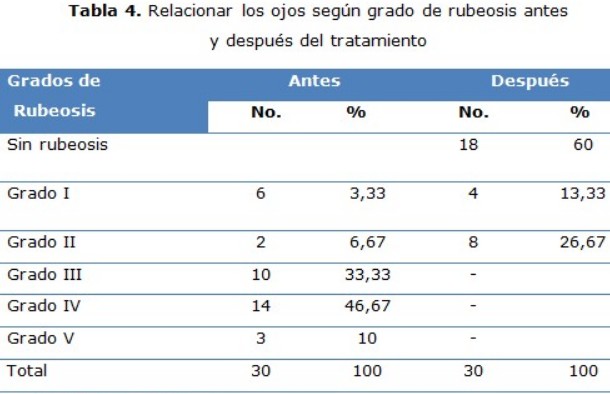Resultados del uso de la triamcinolona intravitrea en pacientes con rubeosis de iris
Abstract
RESUMENFundamento: la rubeosis del iris se asocia generalmente con diferentes enfermedades que producen falta de oxígeno en la retina. La falta de oxígeno hace que se liberen sustancias que estimulan la formación de nuevos vasos sanguíneos (angiogénesis) en un intento del organismo por solucionar la isquemia. La rubeosis de iris es la complicación más frecuente y precoz de muchas enfermedades vasculares del segmento posterior, que conlleva a una pérdida irreversible de la visión si no se diagnostica y se trata oportunamente.
Objetivo: describir el comportamiento de la rubeosis de iris luego del tratamiento con triamcinolona intravítrea.
Método: se realizó un estudio descriptivo de corte longitudinal, en pacientes con rubeosis de iris que acudieron a la consulta de retina del Centro Oftalmológico Carlos J Finlay, desde junio 2013 a junio 2014. El universo de estudio estuvo constituido por 25 pacientes y la muestra no probabilística estuvo formada por 30 ojos que cumplieron los criterios de inclusión, se les aplicó un formulario para recoger los datos. Los resultados se relacionaron con las siguientes variables: tensión ocular, síntomas, enfermedades que provocaron rubeosis de iris, grados de rubeosis.
Resultado: la tensión ocular se estabilizó con el tratamiento empleado, el síntoma más frecuente fue el dolor. La retinopatía diabética proliferativa fue la afección más frecuente en el 40 % de los pacientes, seguido de la trombosis de la vena central de la retina. El estado de la rubeosis mejoró en más de la mitad de los pacientes, algunos con regresión completa.
Conclusiones: la tensión intraocular mejoró después del tratamiento con triamcinolona intravítrea. Los síntomas desaparecieron en más de la mitad de los pacientes. La retinopatía diabética proliferativa fue la enfermedad más frecuente que provocó rubeosis de iris. Este signo desapareció en más de la mitad de los pacientes después del tratamiento.
Background: rubeosis iridis is generally associated to different diseases that produce lack of oxygen in the retina. It is the most frequent and early complication of many vascular diseases of the posterior segment that causes irreversible loss of vision if it is not early diagnosed and treated.
Objective: to describe the behavior of rubeosis iridis after the treatment with intravitreous triamcinolone.
Methods: a descriptive, longitudinal study was conducted in patients with rubeosis iridis who came to the retina consultation of Carlos J. Finlay Ophthalmology Center from June 2013 to June 2014. The universe of the study was composed of 25 patients and the non-probabilistic sample by 30 eyes that matched the inclusion criteria. A form was applied to collect the data. The results were related to the following variables: ocular tension, symptoms, diseases that cause rubeosis iridis and rubeosis degrees.
Results: ocular tension stabilized with the treatment applied. The most frequent symptom was pain. Proliferative diabetic retinopathy was the most frequent disease in the 40 % of the patients, followed by thrombosis of the central retinal vein. More than the half of the patients improved their condition, some of them with a complete regression.
Conclusions: intraocular tension improved after the treatment with intravitreous triamcinolone. Symptoms disappeared in more than the half of the patients. Proliferative diabetic retinopathy was the most frequent disease that caused rubeosis iridis. This sign disappeared in more than the half of the patients after the treatment.
Downloads

Downloads
Published
How to Cite
Issue
Section
License
Copyright: Camagüey Medical Archive Magazine, offers immediately after being indexed in the SciELO Project; Open access to the full text of the articles under the principle of making available and free the research to promote the exchange of global knowledge and contribute to a greater extension, publication, evaluation and extensive use of the articles that can be used without purpose As long as reference is made to the primary source.
Conflicts of interest: authors must declare in a mandatory manner the presence or not of conflicts of interest in relation to the investigation presented.
(Download Statement of potential conflicts of interest)
The Revista Archivo Médico de Camagüey is under a License Creative Commons Attribution-Noncommercial-No Derivative Works 4.0 International (CC BY 4.0).
This license allows others to distribute, to mix, to adjust and to build from its work, even for commercial purposes, as long as it is recognized the authorship of the original creation. This is the most helpful license offered. Recommended for maximum dissemination and use of licensed materials. The full license can be found at: https://creativecommons.org/licenses/












 22 julio 2025
22 julio 2025